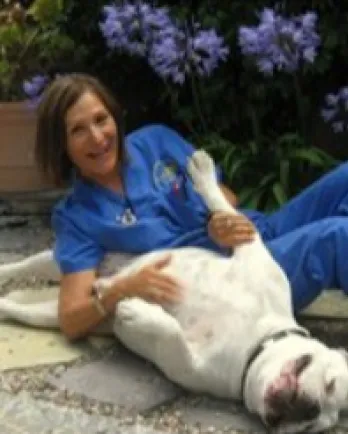Helping Your Dog Cross the Bridge: How to Assess Your Dog's Quality of Life by Dr. Alice Villalobos
This post contains excerpts from the article "Quality of Life" by Dr. Alice Villalobos, which can be read in Your Dog's Golden Years. For additional information about end-of-life issues for pets, see "What is Hospice Care for Pets?" by the veterinarians at Paws into Grace.
Society accepts that humane euthanasia (well death) for companion animals is indeed the best option when quality of life (QoL) is lost and the best way to mercifully end pointless suffering. This viewpoint may have served the veterinary profession and society adequately in the past. But today, pet lovers want more options when their pets are aging or are diagnosed with life-limiting disease or cancer. Modern pain management, high tech medicine, and good nursing care can restore and maintain QoL for longer periods. Caregivers want to extend the timeline between the diagnosis of a terminal disease and death for their companion animals.
It will take time for the entire veterinary profession to embrace palliative care, hospice and/or Pawspice care. Pawspice may start early, when a pet is diagnosed with a life-limiting disease. Pawspice includes treating symptoms and primary disease with kinder, gentler standard care, and transitions to hospice as the animal nears death.
Society’s wish to provide end-of-life care for companion animals raises lots of bioethical questions such as: What are one’s obligations to one's companion animal? Must all of the disorders in my companion animals be addressed? Is palliative care (treating symptoms without intent to cure) good enough? How can one evaluate or assess an animal’s QoL? How can one restore and maintain QoL? How will I know when it is the right time to make the final call for the gift of euthanasia?
QoL is the goal for all who care for pets with life-limiting disease.
The “HHHHHMM” Quality of Life Scale
There was a huge need for a user-friendly QoL scale for companion animals to help everyone involved make proper assessments and decisions along the way to the inevitable conclusion of a terminal patient’s life. In 2004, out of necessity, this author created the HHHHHMM QoL Scale to help pet lovers look at issues that are difficult to face.
The “HHHHHMM” acronym makes it easy to recall the five H’s and two M’s which represent: Hurt, Hunger, Hydration, Hygiene, Happiness, Mobility and More good days than bad days. The QoL Scale is not perfect, but it helps all caregivers to ask themselves if they are truly able to provide enough care to properly maintain their ailing pet’s QoL.
View or download the HHHHHMM Quality of Life Assessment Scale.
Respecting Needs and Desires
Animals have certain needs and desires which should be recognized and respected by their caretakers. The Five Freedoms of Animal Welfare was developed for farm animals in the United Kingdom. Yet, this list is usable for all companion animals. The Five Freedoms are: 1. Freedom from Hunger and Thirst, 2. Freedom from Discomfort, 3. Freedom from Pain, Injury, or Disease, 4. Freedom to Express Normal Behavior, 5. Freedom from Fear and Distress. If one is able to maintain the five basic needs and desires during end-of-life care, then there is justification for pet owners to care for their failing pets with palliative care programs and Pawspice or hospice.
The HHHHHMM QoL Scale helps animal caregivers confidently determine what a satisfactory QoL should be. The most important QoL factors to monitor are: pain, respiration, blood flow, maintaining adequate nutrition, hydration, and temperature. Factors to avoid are depression and frustration.
View or download the HHHHHMM Quality of Life Assessment Scale.
Hospitalization
How long should a sick or dying animal remain in the hospital? Most experts agree that it is in the animal’s best interest to be at home with familiar, consistent routine and surroundings. Hospitalized pets are susceptible to the same “hospitalism” syndrome (failure to thrive) that infants and geriatric people acquire when they are hospitalized for long periods. Hospitalism occurs because infants and geriatric patients were only handled when wet, being fed, or medicated.
Efforts to avoid hospitalism for end-of-life pets are justified. This would include considering the hospice option for companion animals that are taken to emergency clinics in sub acute and acute terminal crisis conditions.
Pain Assessment
Millions of companion animals suffer in silence without their families recognizing it. Animals do not exhibit pain the way that people do. To prevent animal suffering, people need to recognize it. Pain assessment aids and questionnaires may yield variable results due to owner ignorance, inexperience, insensitivity and bias. Veterinarians are highly trained to assess for all types of pain during the physical examination. They will ask questions and educate pet owners to look for signs of pain.
The horrible and desperate pain of respiratory distress ranks at the top for humans and it is presumed to be the same for animals. Not being able to breathe outweighs all other criteria. Respiratory distress is an emergency and it must be relieved immediately or there is no QoL for the animal and there is no humane justification to continue the hospice.
Nutrition and Appetite
Weight loss can be sneaky under the beautiful coat that most companion animals were blessed with. Therefore monitoring an older or ill pet’s weight is essential. Malnutrition, weight loss, and cancer cachexia (extreme weight loss due to cancer) develop quickly in animals when their appetite is poor. Pet owners are often not educated regarding minimum caloric intake or resting energy requirement (RER).
The veterinarian can prescribe appetite stimulants such as mirtazapine. Along with coaxing, hand feeding or gentle force feeding with wholesome, flavorful foods, one might restore and maintain adequate nutritional intake for their failing pet.
If a dog or cat drops 10% of body weight and is not consuming its resting energy requirement for 3-5 days, then feeding tube placement must be considered. This option prevents further weight loss and decline from malnutrition, dehydration and starvation while maintaining gut health. Blended or liquid recovery diets will help maintain proper nutritional and caloric intake via an E-Tube. At times, attending doctors and pet owners are not in favor of placing feeding tubes for end-of-life care; however, patients need and require adequate nutrition if a good QoL hospice is to continue.
Every companion animal being kept in end-of-life care should be given adequate fluid intake (two teaspoons or 10 ml per pound per day). The veterinarian can teach caregivers to assess their pet’s hydration by the pinch method. If the pinched skin is slow to return to normal position, the animal is dehydrated. Giving subcutaneous (SQ) fluids at home is a wonderful way to supplement the fluid intake of ailing pets. This saves money and keeps the patient healthier with a huge improvement in QoL.
Mental Well-Being
A good Pawspice must include a two way exchange of pleasure and contentment between the pet owner and the pet along with enrichment that encourages as much fun as possible. Happiness generates good physiology and mental well-being and longer survival times. It is important to create frequent moments of enjoyment for the ailing pet. Many end-of-life pets cheer up and look forward to these uplifting events. The beneficial effect of joy and happiness may be from increasing the “serum fun factors.” Having fun during these special days can make a world of difference for family members and the patient.
The human pediatric cancer care model strives to entertain children with enjoyable programs, and so does Pawspice. End-of-life pets need to derive some pleasure from being alive and some enjoyment (being petted and talked to) for a good part of their day and to have actual fun if at all possible.
Ask these questions. Does the pet express joy and show interest in the family? Is the pet responsive to caressing and the environment? Is the pet depressed, lonely, anxious, bored or afraid? Is the pet isolated? Can the pet's bed be moved near family activities and be in the middle of things?
Framework for Ethical Decision Making
For an additional resource, download the Framework for Ethical Decision Making. [The Framework] urges all involved parties, including attending doctors, specialists, hospital staff and the family, to reach consensus and comfort with their decisions especially in their final decisions. When adapting this framework for animals, caregivers must prioritize the pet’s best interests and QoL.
Summary
Companion animal lovers have an ethical obligation to maintain QoL as their pets age and enter the newly recognized and unavoidable stage of life that is “End of Life.” The HHHHHMM QoL Scale is a user friendly tool which directs caregivers to assess and score eight essential criteria for QoL on a monthly, weekly, daily or hourly basis as needed. The family can learn to conscientiously monitor and improve their failing pet’s QoL score to maintain an acceptable well being which validates the human-animal bond. Using the Framework for Ethical Decision Making can also help pet lovers make difficult decisions.
End-of-life care focuses on QoL by adopting palliative care, hospice or Pawspice instead of curative treatment. Focusing on QoL may be the best option for terminal patients to avoid "the mindless machinery of medicine" that so many human patients and their families are coerced into electing in the either or/can do medicine model. Focusing on QoL for companion animals with life-limiting disease may avoid futile medicine, overtreatment and reluctant early euthanasia. Focusing on QoL allows the human-animal bond to last longer and allows terminal pets and their families to enjoy a celebrated new stage of life that truly is a journey end of life. “Primum Non Nocere. First, do no harm.” Hippocrates
The information presented by The Grey Muzzle Organization is for informational purposes only. Readers are urged to consult with a licensed veterinarian for issues relating to their pet's health or well-being or prior to implementing any treatment.
The full text of this article by Dr. Alice Villalobos can be found in Your Dog's Golden Year, edited by Jennifer Kachnic, President of The Grey Muzzle Organization.
The Grey Muzzle Organization improves the lives of at-risk senior dogs by providing funding and resources to animal shelters, rescue organizations, sanctuaries, and other nonprofit groups nationwide.





